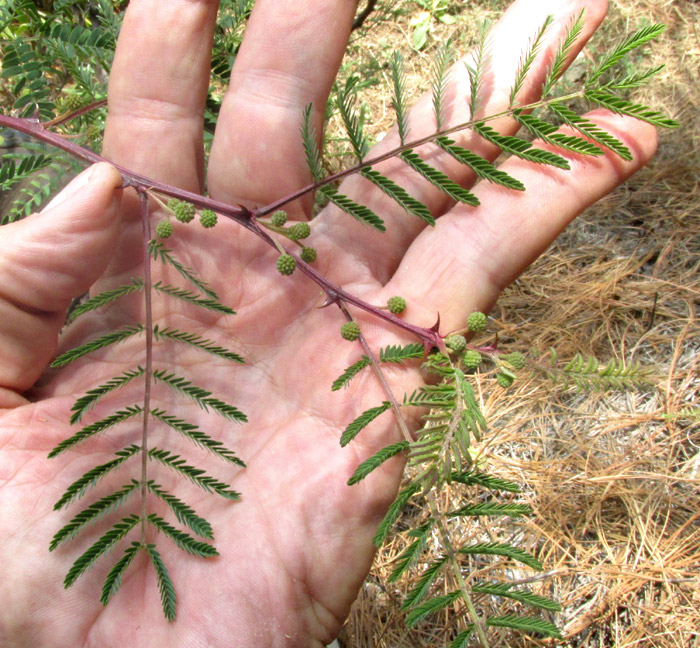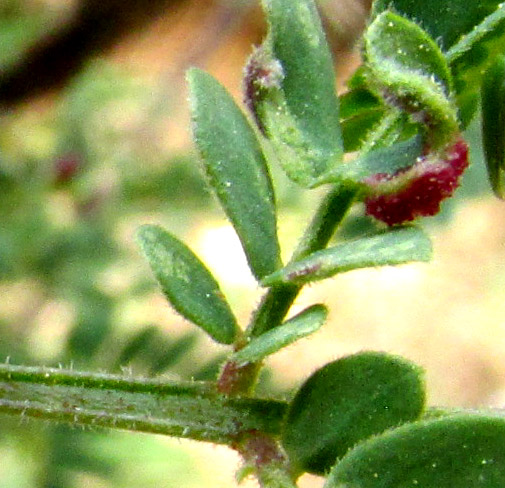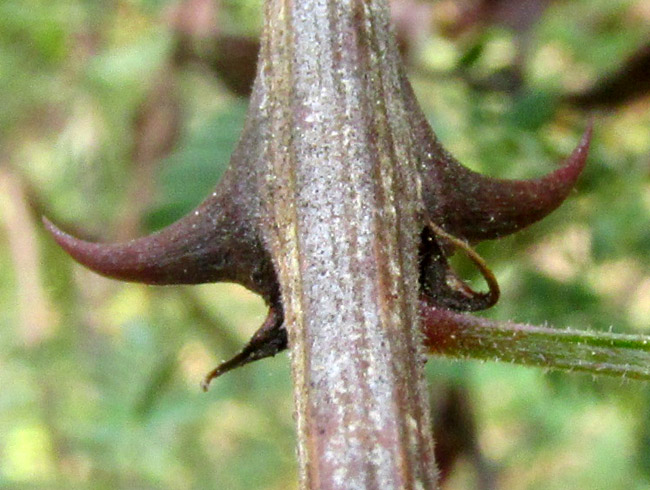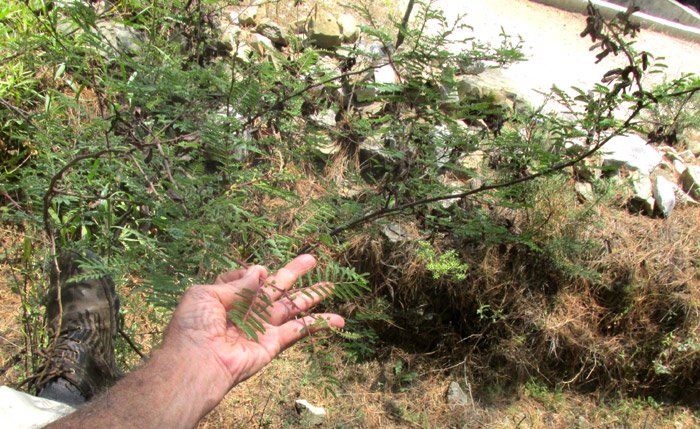Excerpts from Jim Conrad's
Naturalist Newsletter
entry from field notes dated May 5, 2023, taken along paved road to El Doctor, about 2km above intersection with Hwy 120 running east to San Joaquín; juniper, oak and pine forest on limestone bedrock; elevation ±2500m (8200 ft); Eastern Sierra Madre mountains of east-central Querétaro state, MÉXICO, (N20.88°, W99.62°)
THE UNOFFICIAL "MIMOSA ACULEATICARPA COMPLEX"

On a steep, rocky slope along the road to El Doctor, a spindly understory shrub hardly over knee high but sprawling somewhat made a living in a spot usually shaded by junipers and pines. It was the feathery leaves, shown above, that caught my attention, typical of various shrubs and trees of the Mimosa Subfamily of the huge Bean Family, the Fabaceae. However, that family forms a hugely diverse, species rich branch of the phylogenetic Tree of Life, so sometimes you run into something especially interesting, so to identify what you're seeing, it's always good to pay attention to details.
In the above picture, important field marks include that there are thick-based, sharp, backward-curving spines on the stems, so this is one of any number of plants in Spanish known as uñas de gatas, or "catclaws" in English. The leaves are twice pinnately compound -- divided into nine or so primary divisions, or pinnae, with each pinna divided into 15 or thereabouts pairs of leaflets. The stems, spines and leaf rachises are a rose-purple hue.

Up close it's seen that the leaf petioles are curiously squared with thickened edges, and are weakly short-hairy. Leaflet undersurfaces and margins also are halfhartedly hairy, but leaflet tops appear to be hairless, or nearly so. The raspberry-colored items may be very immature inflorescences.


Fortunately for IDing purposes, certain stems bore the last season's legume-type fruits, seen above and at the right. The legumes are flattened and arise in clusters of three or so from atop a common peduncle. On the margins of some legumes a few short, curved spines appear, but on others there's just one or none.

The spines caught my attention because often they appeared to have secondary spines at their bases. As seen above, the lower spines were just especially long-pointed stipules, which are modified leaves which help protect leaves during their embryonic stage. Usually but not always, soon after leaves unfurl, if stipules are present in the first place, they fall off, no longer needed, leaving only scars. In the Bean Family, often stipules are permanent and conspicuous.
Finally, here's the little bush itself, on a slope so steep that to reach out with my hand I dangled my leg downslope to keep from sliding down:

The flat legume with occasional broad-based spines along the margins and the twice-pinnate leaves on a woody bush were so typical of mimosas, genus Mimosa, that that's where I looked first for species with features matching ours.
In our part of upland central Mexico known as the Bajío, if you have a mimosa whose leaves are divided into nine or so pinnae, and each pinna produces 15 or so leaflets, the legumes are not conspicuously cross-divided into parts that when mature can fall out separately, plus the legumes often produce one to several conspicuous, broad-based spines along their margins, and the leaves and stems are half-heartedly short-hairy, you have one of three very similar species: Mimosa aculeaticarpa, M. biuncifera, or M. rhodocarpa, all found in the region of this field trip and all occurring generally in the Mexican uplands.
The Flora del Bajío says of this complex of look-alikes that the species are very variable in their morphology. The identification key in the Flora neatly separates the species. Mimosa biuncifera is said to bear no broad-based spines on its legumes, while some of our legumes have them but others don't. Leaves of M. aculeaticarpa are said to develop 10-16 pairs of pinnae, while M. rhodocarpa produces 4-8, while our plant's leaves center around the intermediate nine. Mimosa aculeaticarpa is said to be different from the others because of its "diffuse branching of stems," ... ramificación difusa de los tallos, which sounds like our bush, but pictures on the Internet don't confirm this, and our bush might produce diffuse branching because it's shaded by junipers and pines.
Though I'm sure that plants exist neatly fitting one of the species as represented in the keys, I strongly suspect that these three species are all local expressions of the same species. I'm filing this under the name MIMOSA ACULEATICARPA COMPLEX, even though I find no studies defining such a complex formally. The name aculeaticarpa has precedence because it was recognized earliest, in 1800, while biuncifera came along only in 1839, and rhodocarpa didn't appear until 1987.
The distribution of Mimosa aculeaticarpa extends into the US states of Arizona, New Mexico and Texas, where it's called Catclaw Mimosa. US botanists tend to recognize Mimosa biuncifera as a variety of Mimiosa aculeaticarpa, forming Mimosa aculeaticarpa var. biuncifera. However, at this writing, the "Kew Plants of the World database" rejects that formulation in favor of the original M. biuncifera.
In the US, Catclaw Mimosa is considered an invader of desert and semiarid grasslands, as a consequence of fire suppression and livestock grazing, cattle gladly eating the legumes, and dispersing the seeds. The species is fire tolerant, in that fires burn its stems, but then what's left underground sprouts.
Whatever the case, it was a pleasure meeting this little being making the best of a shady spot on a very dry, steep, rocky slope in this obscure corner of the central Mexican mountains, it doing its thing and I doing mine.